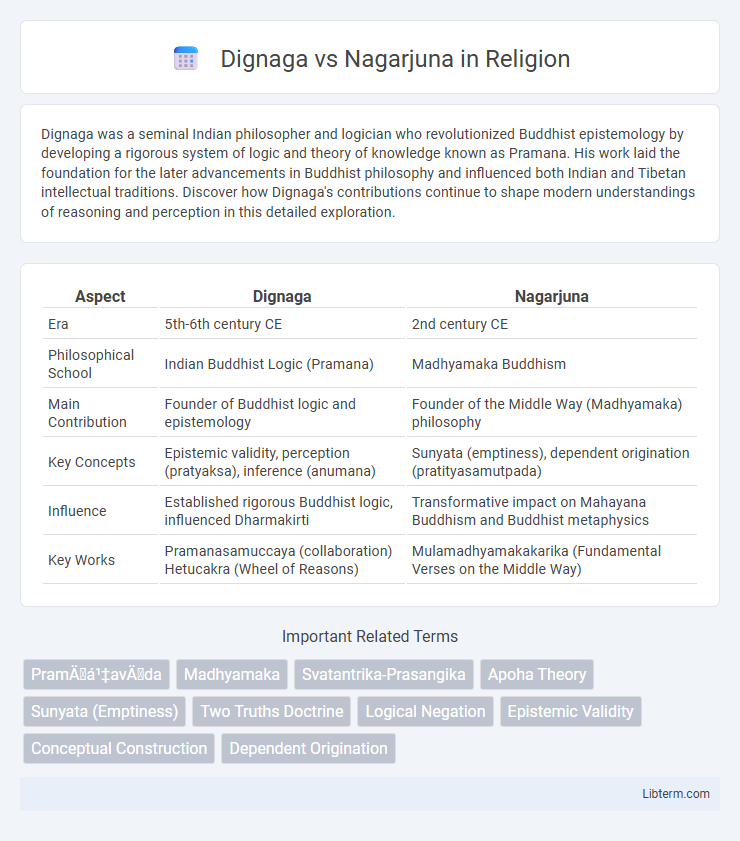Dignaga was a seminal Indian philosopher and logician who revolutionized Buddhist epistemology by developing a rigorous system of logic and theory of knowledge known as Pramana. His work laid the foundation for the later advancements in Buddhist philosophy and influenced both Indian and Tibetan intellectual traditions. Discover how Dignaga's contributions continue to shape modern understandings of reasoning and perception in this detailed exploration.
Table of Comparison
| Aspect | Dignaga | Nagarjuna |
|---|---|---|
| Era | 5th-6th century CE | 2nd century CE |
| Philosophical School | Indian Buddhist Logic (Pramana) | Madhyamaka Buddhism |
| Main Contribution | Founder of Buddhist logic and epistemology | Founder of the Middle Way (Madhyamaka) philosophy |
| Key Concepts | Epistemic validity, perception (pratyaksa), inference (anumana) | Sunyata (emptiness), dependent origination (pratityasamutpada) |
| Influence | Established rigorous Buddhist logic, influenced Dharmakirti | Transformative impact on Mahayana Buddhism and Buddhist metaphysics |
| Key Works | Pramanasamuccaya (collaboration) Hetucakra (Wheel of Reasons) |
Mulamadhyamakakarika (Fundamental Verses on the Middle Way) |
Introduction to Dignaga and Nagarjuna
Dignaga, a 5th-6th century Indian Buddhist philosopher, is renowned for founding the Buddhist logic (pramana) tradition, emphasizing epistemology and the theory of perception and inference. Nagarjuna, who lived earlier around the 2nd century CE, is celebrated as the founder of the Madhyamaka school of Mahayana Buddhism, known for his profound doctrine of emptiness (sunyata) and critique of intrinsic existence. While Nagarjuna's work primarily addresses metaphysical ontologies, Dignaga concentrates on formalizing valid means of knowledge, significantly influencing Buddhist epistemology and logic.
Historical Context and Philosophical Background
Dignaga (c. 480-540 CE) and Nagarjuna (c. 150-250 CE) represent pivotal figures in Indian Buddhist philosophy, with Nagarjuna laying the foundation of Madhyamaka school emphasizing emptiness (sunyata) and dependent origination, while Dignaga pioneered Buddhist logic and epistemology, forming the Pramana school. Nagarjuna's work addressed metaphysical questions during the early centuries of the Common Era, responding to prevailing Hindu and Buddhist doctrines by dismantling inherent existence concepts. Dignaga expanded this tradition in the 5th to 6th century CE, focusing on the nature of knowledge and perception, thereby shaping the epistemic frameworks critical for later Buddhist scholarship across Tibet and East Asia.
Core Teachings of Nagarjuna
Nagarjuna, a foundational figure in Mahayana Buddhism, developed the doctrine of Sunyata (emptiness), emphasizing that all phenomena lack inherent existence and arise dependently through Pratityasamutpada (dependent origination). His philosophical treatises, particularly the Mulamadhyamakakarika, argue that reality transcends conceptual extremes of existence and non-existence, promoting the Middle Way philosophy. Contrasting with Dignaga's focus on Buddhist logic and epistemology, Nagarjuna centers on metaphysical insight into emptiness as a path to liberation.
Fundamental Doctrines of Dignaga
Dignaga's fundamental doctrines revolutionized Buddhist epistemology by establishing a formal system of logic and perception as sources of valid knowledge (pramana), contrasting with Nagarjuna's emphasis on emptiness (shunyata) and the rejection of inherent existence. Dignaga introduced the strict criteria for valid cognition, distinguishing between direct perception (pratyaksha) and inference (anumana) while minimizing metaphysical speculations. His work laid the groundwork for later Buddhist logicians by systematizing knowledge acquisition based on experience and reason, diverging from Nagarjuna's dialectical method aimed at deconstructing conceptual assumptions.
Approach to Logic and Epistemology
Dignaga revolutionized Buddhist logic by developing a formal system of inferential reasoning based on the theory of perception (pratyaksa) and inference (anumana), emphasizing the direct apprehension of reality through valid cognition (pramana). Nagarjuna, foundational to the Madhyamaka school, employed dialectical reasoning to deconstruct inherent existence and asserted the emptiness (sunyata) of all phenomena, highlighting the limits of conceptual knowledge rather than establishing a formal epistemic framework. While Dignaga advanced analytic tools for rigorous epistemology, Nagarjuna's approach centered on philosophical skepticism and the negation of inherent essences to transcend conceptual fabrication.
Emptiness (Śūnyatā) vs. Pramāṇa Theory
Dignaga's Pramana Theory emphasizes valid cognition through perception (pratyaksa) and inference (anumana), forming the basis for epistemology in Buddhist logic. Nagarjuna's concept of Emptiness (Sunyata) deconstructs inherent existence, asserting all phenomena lack intrinsic nature and arise dependently, challenging substantialist views. While Dignaga seeks reliable means of knowledge, Nagarjuna critiques the notion of fixed reality, creating a dialectic between epistemic certainty and ontological emptiness.
Debates on Reality and Perception
Dignaga and Nagarjuna represent pivotal figures in Buddhist philosophy with contrasting approaches to reality and perception. Nagarjuna's Madhyamaka school asserts the concept of sunyata (emptiness), emphasizing that all phenomena lack intrinsic existence, thus reality is dependent on relational interdependence. Conversely, Dignaga, founder of Buddhist logic and epistemology, prioritizes perception (pratyaksa) and inference (anumana) as valid means of knowledge, arguing that cognition is the sole criterion for reality, which underscores the debate on the nature of truth and epistemic access.
Influence on Buddhist Philosophy
Dignaga revolutionized Buddhist philosophy by developing a formal system of logic and epistemology, emphasizing pramana (valid means of knowledge), which significantly influenced subsequent Buddhist scholastic traditions. Nagarjuna's foundational work in Madhyamaka introduced the doctrine of emptiness (shunyata), profoundly reshaping metaphysical perspectives on reality and interdependent origination. The dialectical methodologies of Nagarjuna and the logical rigor of Dignaga collectively transformed Buddhist thought, balancing ontological critique with epistemological precision.
Comparative Analysis: Similarities and Differences
Dignaga and Nagarjuna both significantly shaped Indian Buddhist philosophy, yet their methods and emphases differed markedly. Nagarjuna's Madhyamaka school centered on the concept of sunyata (emptiness), asserting the lack of inherent existence in all phenomena to dismantle metaphysical views, whereas Dignaga pioneered Buddhist logic and epistemology, emphasizing pramana (valid cognition) to establish a systematic approach to knowledge and inference. Their shared focus on deconstructing inherent nature converges philosophically, but Nagarjuna's dialectical methods contrast with Dignaga's analytical rigor in epistemic validation.
Legacy in Indian and Tibetan Thought
Dignaga revolutionized Indian and Tibetan thought by founding the Buddhist school of logic and epistemology, emphasizing pramana (valid knowledge) and shaping later Buddhist philosophy. Nagarjuna's legacy lies in establishing the Madhyamaka school, advocating the philosophy of emptiness (shunyata), deeply influencing both Mahayana Buddhism and Tibetan doctrinal frameworks. Together, their contributions form the cornerstone of Indian and Tibetan Buddhist scholastic traditions, blending dialectical methods with ontological insights.
Dignaga Infographic

 libterm.com
libterm.com